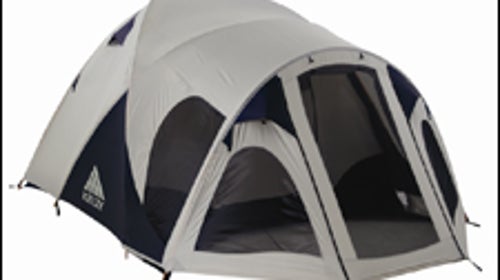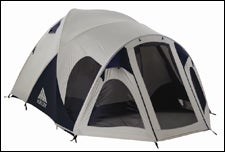After having never attempted a 24-hour race of any kind, I completed two on consecutive weekends this past February. The first was the 24 Hours of Sunlight, a ski race near Aspen, Colorado; the second, the 24 Hours in the Old Pueblo mountain-bike race just north of Tucson, Arizona. I was on five-person coed teams at both events, which I thought would take some of the sting out. It did. But it also taught me that racing on a team adds a whole different level of planning and coordination that can be as exhausting as the race itself. Food, rest, gear repairs, and clothing changes all have to be tended to around hourly comings and goings in cramped quarters, as teammates start or finish their laps. And when you’re between laps, you don’t want to be dealing with anything but a bowl of rice and a nap. I think most solo 24-hour racers have decided that the pain of racing nonstop for a full day is a small price to pay for the simplicity of it all.
Kelty Pavilion 6 Tent
 Kelty Pavilion 6 Tent
Kelty Pavilion 6 TentAt Sunlight, we managed well enough in a one-room condo. But at Tucson—where a lot of the “fun” of the race comes from any combination of brutal winds, heavy rains, and searing sun—we would be camping in a temporary tent city of about 3,000 people. My teammates and I would be sleeping in our own tents. But we needed a central hub where we could cook, change, eat, drink, and bond as a group, protected from the elements—and where we could actually stand up. Our choice was the Kelty Pavilion 6.
Kelty makes bigger tents, including some with separate rooms, which might have been a nice touch for clothing changes on a coed team. But the Pavilion’s aluminum poles—the larger choices came with lightweight fiberglass poles—made it the obvious choice for the desert winds and the unsteady midnight stumbling atop race-weary legs. Also, the hangar-size screened vestibule looked like a perfect place for food storage and preparation away from the wind and bugs.
A very patient teammate of mine (thanks, James) set the Pavilion up on his own in just under an hour, but he was pitching it for the first time and in fierce winds. I’ve since managed to get it up by myself in calmer conditions in less than 30 minutes. Considering that the total area (tent and vestibule) of 204 square feet was only slightly smaller than my first New York apartment (seriously), this seems fair enough. And once the Pavilion is up, it stays up. I saw a number of smaller tents and banners succumb to the wind in Tucson. But the Pavilion—which, at 79 inches tall, was much more exposed than most tents—held its ground. Just as impressively, it stood up against all manner of mistreatment on our part: bikes leaned against the outside, boxes, bags, and ice chests strewn about inside. We pitched the tent on a mix of rock and rock-hard dirt, without any sort of ground covering, then spent much of the next 24 hours walking inside in cleated mountain-bike shoes. Not a single hole in the floor.
The vestibule became our gear locker and food-prep area. Even with boxes of bike parts and headlamps, a tool kit, backpacks, trash bags, and ice chests, there was enough room to move around and access any of it. Inside, the gaping internal gear pockets held shoes, helmets, and assorted filthy bike clothes. With all the spent jerseys, shorts, and socks, things could have gotten pretty ripe in the midday heat. But the mesh ceiling and wall vents kept the Pavilion well ventilated and funk-free, even with the fly on.
The Pavilion 6 isn’t made for packing into the Grand Canyon (at 27 lbs., this is a car-only tent). But if it’s 3 a.m. and all you want to do is peel off your bike clothes and cook a bit of pasta while your teammate tries to true a wheel—all in the middle of a dust storm—you’ll be glad to call it home. $525;


